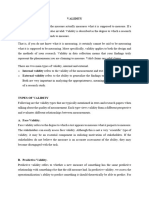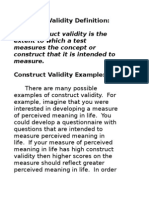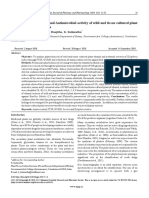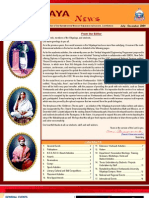0 ratings0% found this document useful (0 votes)
6 views10 Validity
10 Validity
Uploaded by
gelosamonte041300Copyright:
© All Rights Reserved
Available Formats
Download as PDF, TXT or read online from Scribd
10 Validity
10 Validity
Uploaded by
gelosamonte0413000 ratings0% found this document useful (0 votes)
6 views5 pagesOriginal Title
10validity
Copyright
© © All Rights Reserved
Available Formats
PDF, TXT or read online from Scribd
Share this document
Did you find this document useful?
Is this content inappropriate?
Copyright:
© All Rights Reserved
Available Formats
Download as PDF, TXT or read online from Scribd
Download as pdf or txt
0 ratings0% found this document useful (0 votes)
6 views5 pages10 Validity
10 Validity
Uploaded by
gelosamonte041300Copyright:
© All Rights Reserved
Available Formats
Download as PDF, TXT or read online from Scribd
Download as pdf or txt
You are on page 1of 5
CHAPTER 10: VALIDITY
It refers to the degree to which the measurement procedure measures
the variable that it claims to measure (strength, usefulness, quality,
appropriateness, etc).
Does the measurement process accurately capture the
variable/construct that it is supposed to measure?
Basically, it is the agreement between a test score and the characteristic
it is believed to measure.
Aspects of Validity
Face Validity – is the simplest and least scientific form of validity and
it is demonstrated when the face value or superficial appearance of a
measurement measures what it is supposed to measure.
Do the test items appear related to the perceived purpose of the
test?
Examples of Face Validity
An IQ test containing items which measure memory,
mathematical ability, verbal reasoning and abstract reasoning
has a good face validity.
An IQ test containing items which measure depression and
anxiety has a bad face validity.
A self-esteem rating scale which has items like “I know I can do
what other people can do.” and “I usually feel that I would fail on
a task.” has a good face validity.
Content Validity - is concerned with the extent to which the test is
representative of a defined body of content consisting of topics and
processes.
Content validation is not done by statistical analysis but by the
inspection of items. A panel of experts can review the test items and
rate them in terms of how closely they match the objective or domain
specification.
This considers the adequacy of representation of the conceptual domain
the test is designed to cover.
If the test items adequately represent the domain of possible items for
a variable, then the test has adequate content validity.
Determination of content validity is often made by expert judgment.
Construct underrepresentation
Failure to capture important components of a construct (e.g. An
English test which only contains vocabulary items but no
grammar items will have a poor content validity.)
Construct-irrelevant variance
Happens when scores are influenced by factors irrelevant to the
construct (e.g. test anxiety, reading speed, reading
comprehension, illness)
Quantification of Content Validity
– Lawshe (1975) proposed a structured and systematic way of
establishing the content validity of a test
– He developed the formula content validity ratio (CVR)
Criterion Validity - involves the relationship or correlation between the
test scores and scores on some measurement representing an identical
criterion.
The correlation coefficient can be computed between the scores on the
test being validated (predictor) and the scores on the criterion.
The correlation coefficient (Pearson r) used is called validity coefficient.
Types of Criterion Validity
Predictive Validity
It is demonstrated when scores obtained from a measure accurately
predict behavior (criterion) according to a theory.
Examples:
College entrance tests can predict whether a student can meet the
demands and standards of the college/university. These tests are
good correlates of academic performance.
Job application exams can predict the job performance and
attitude of applicants.
Concurrent Validity
It is established when the scores of a measure (predictor) is correlated
with the scores of a different measure (criterion) taken at the same time.
The two measures may be measuring the same construct, but often
times they measure two different yet related constructs.
A newly created psychological test (predictor) must correlate with
existing and well-established psychological tests (criterion) measuring
a related construct.
Examples:
A test which measures learning disabilities should be significantly
and negatively correlated with a test measuring school
performance.
A test which measures anger is expected to be significantly and
positively correlated with a test measuring violent and aggressive
behavior.
An individual who got a high score on a newly constructed test
which measures depression is expected to get a high score in Beck
Depression Inventory-II.
Construct Validity
A test has a good construct validity if there is an existing psychological
theory which can support what the test items are measuring.
Establishing construct validity involves both logical analysis and
empirical data.
Example: In measuring aggression, you have to check all past research
and theories to see how the researchers measure that
variable/construct.
Types of Construct Validity
Convergent Validity
It involves comparing two different methods to measure the same
construct and it is demonstrated by a strong relationship between the
scores obtained from the two methods.
This can be demonstrated through:
A test measuring the same things as other tests used for the same
purpose.
Demonstration of specific relationships that we can expect if the
test is really doing its job.
Examples:
Your newly created psychological test measuring life satisfaction
should be strongly and positively correlated with “Satisfaction
with Life Scale” by Ed Deiner, Ph,D.
In measuring children’s aggression, you may observe their
behavior directly and you may also ask their parents to
accomplish an aggression rating scale.
Divergent Validity or Discriminant Validity
This refers to the demonstration of the uniqueness of that test.
It is effectively demonstrated when a test has a low correlation with
measures of unrelated constructs.
It could simply mean that the measure does not represent a construct
other than the one for which it was devised.
Examples:
In measuring children aggression, you have to distinguish what
is the kids’ general activity and what is real aggression.
Your newly constructed psychological test about optimism should
have a weak correlation with a test which measures gender
identity.
A test which measures spelling ability should have a low
correlation with a test which abstract reasoning.
Relationship between Reliability and Validity
• Reliability and validity are partially related and partially independent.
• Reliability is a prerequisite for validity, meaning a measurement
cannot be valid unless it is reliable.
• It is not necessary for a measurement to be valid for it to be
considered reliable.
You might also like
- Gilete Guide James AyoteDocument87 pagesGilete Guide James AyoteWesllen Figueira100% (1)
- Dawlance Audit ReportDocument26 pagesDawlance Audit ReportWaqas Ahmad83% (6)
- Yamaha YST-SW030 SubwooferDocument26 pagesYamaha YST-SW030 Subwooferbawbaw1No ratings yet
- 3 VALIDITY - RELAIBILITY 18032024 101010amDocument55 pages3 VALIDITY - RELAIBILITY 18032024 101010amEliz mockNo ratings yet
- What Is Validity in ResearchDocument6 pagesWhat Is Validity in ResearchRuhi KapoorNo ratings yet
- ValidityDocument12 pagesValidityAmna GhafoorNo ratings yet
- M. Shah Jahan 100127 To SIR Farukh Gill (Task 2Document26 pagesM. Shah Jahan 100127 To SIR Farukh Gill (Task 2Roy JohnNo ratings yet
- Validity Explains How Well The Collected Data Covers The Actual Area of InvestigationDocument7 pagesValidity Explains How Well The Collected Data Covers The Actual Area of Investigationlaiba israrNo ratings yet
- StrructuresDocument28 pagesStrructuresgwenstacyNo ratings yet
- 8602 (6) 2Document15 pages8602 (6) 2aliahmad28521No ratings yet
- Psychological AssessmentDocument47 pagesPsychological AssessmentAhsan Khan NiaziNo ratings yet
- Alphy Biju BAP.21.440 Assignment On Validity PsychologyDocument6 pagesAlphy Biju BAP.21.440 Assignment On Validity Psychologyalphy bijuNo ratings yet
- Assessment ChurvaDocument3 pagesAssessment ChurvaPajarillo John Mark D.No ratings yet
- Validity Refers To How Well A Test Measures What It Is Purported To MeasureDocument6 pagesValidity Refers To How Well A Test Measures What It Is Purported To MeasureGilbert BersolaNo ratings yet
- ValidityDocument13 pagesValidityBILOG, CHYNNA GNo ratings yet
- Vii. ValidityDocument3 pagesVii. ValidityHannah ItugotNo ratings yet
- Breakdown of ValidityDocument4 pagesBreakdown of ValiditydikahunguNo ratings yet
- NOTE 5 - Validity and Data Gathering TechniqueDocument6 pagesNOTE 5 - Validity and Data Gathering Techniquedennisozioma246No ratings yet
- Reliability and ValidityDocument27 pagesReliability and ValidityBeverly RomaNo ratings yet
- ValidityDocument26 pagesValidityRathiNo ratings yet
- Wksheet 5 StudyguideDocument3 pagesWksheet 5 Studyguidehshah6155No ratings yet
- Meaning and Types of ValidityDocument12 pagesMeaning and Types of ValidityLian YueNo ratings yet
- Validity and Its TypesDocument4 pagesValidity and Its TypesMujahid SulaimanNo ratings yet
- Validity & ReliabilityDocument27 pagesValidity & ReliabilityDeepti ARNo ratings yet
- ValidityDocument36 pagesValidityMuhammad FaisalNo ratings yet
- Assignment 1 8602 Spring 2023Document23 pagesAssignment 1 8602 Spring 2023Mrs SaadNo ratings yet
- Reliability and Validity in AssessmentDocument5 pagesReliability and Validity in AssessmentLucas González Lepesqueur100% (1)
- Characteristics of A Good Test: Validity and Reliability Criteria of Assessment and Rubric of ScoringDocument6 pagesCharacteristics of A Good Test: Validity and Reliability Criteria of Assessment and Rubric of Scoringyakub ismailNo ratings yet
- Exploring Reliability in Academic AssessmentDocument6 pagesExploring Reliability in Academic AssessmentNasir khan Khattak1No ratings yet
- InesSinthyaBrPandia - Reliability and Validity (Repitition, Review)Document3 pagesInesSinthyaBrPandia - Reliability and Validity (Repitition, Review)Ines Sinthya PandiaNo ratings yet
- Unit 6 8602Document22 pagesUnit 6 8602ilyas100% (1)
- 8602 2nd AssignmentDocument48 pages8602 2nd AssignmentWaqas AhmadNo ratings yet
- Reliability and Validity: Written Report in Educ 11aDocument4 pagesReliability and Validity: Written Report in Educ 11aMarkNo ratings yet
- Notes On Reliability and Validity TestDocument3 pagesNotes On Reliability and Validity TestSafiah Lia0% (1)
- ValidityDocument8 pagesValidityTanyaNo ratings yet
- Validity: Validity Refers To Whether A Study Is Able To Scientifically Answer The QuestionsDocument10 pagesValidity: Validity Refers To Whether A Study Is Able To Scientifically Answer The Questionssaad209No ratings yet
- Chapter 6Document3 pagesChapter 6zanoriaakieshaNo ratings yet
- Question No. 1: What Is The Purpose of Validity of A Test? Test ValidityDocument34 pagesQuestion No. 1: What Is The Purpose of Validity of A Test? Test ValidityMathar BashirNo ratings yet
- Methods in Behavioral Research 12th Edition Cozby Solutions Manual 1Document8 pagesMethods in Behavioral Research 12th Edition Cozby Solutions Manual 1william100% (63)
- Split-Half MethodDocument14 pagesSplit-Half MethodBahria studentNo ratings yet
- Validity: Syed Hassan Shah Kargil (Ladakh)Document15 pagesValidity: Syed Hassan Shah Kargil (Ladakh)Caryll Apellanes BaylonNo ratings yet
- Equivalency ReliabilityDocument6 pagesEquivalency ReliabilityMico Maagma CarpioNo ratings yet
- LESSON-ACTIVITIES VII: How Do I Know Whether Students Learned? AssessmentDocument6 pagesLESSON-ACTIVITIES VII: How Do I Know Whether Students Learned? Assessmenttom LausNo ratings yet
- Validity Types - Test ValidityDocument3 pagesValidity Types - Test ValidityCiobanu Iulia100% (1)
- Reliability Vs Validity in ResearchDocument12 pagesReliability Vs Validity in Researchnurwadia100% (1)
- Reliability & ValidityDocument15 pagesReliability & ValiditywajahatroomiNo ratings yet
- Validity and ReliabilityDocument6 pagesValidity and ReliabilityfarlynzNo ratings yet
- Validity 2Document3 pagesValidity 2jakecalbang22No ratings yet
- Test Worthiness: Validity, Reliability, Cross-Cultural Fairness, and PracticalityDocument7 pagesTest Worthiness: Validity, Reliability, Cross-Cultural Fairness, and PracticalityJeffrey ManzanoNo ratings yet
- ValidityDocument7 pagesValidityMAYLENE CUENCONo ratings yet
- Reliability and Validity Aspects in MeasurementDocument4 pagesReliability and Validity Aspects in MeasurementArpita Chakraborty0% (1)
- Past Papers Reliability of Psychological TestsDocument13 pagesPast Papers Reliability of Psychological Testsmana070201No ratings yet
- Advanced Psychometrics RequirementDocument15 pagesAdvanced Psychometrics Requirementbryl john lawrence villamarNo ratings yet
- Kyu Edu 2301 WK3Document5 pagesKyu Edu 2301 WK3suleimanmwamsunyeNo ratings yet
- Test Validity and ReabilityDocument11 pagesTest Validity and ReabilityRamareziel Parreñas RamaNo ratings yet
- 8602 Assignment No 2Document24 pages8602 Assignment No 2Fatima YousafNo ratings yet
- Kuliah 9 - Kesahan Dan Kebolehpercayaan InstrumenDocument31 pagesKuliah 9 - Kesahan Dan Kebolehpercayaan InstrumenAINATY BT MD. YUSOF WATTY -No ratings yet
- AIL Unit 3Document26 pagesAIL Unit 3julian.alipatNo ratings yet
- Presentation GuideDocument2 pagesPresentation GuideMKWD NRWMNo ratings yet
- Reliability and ValidityDocument6 pagesReliability and ValidityJay-ar MasulotNo ratings yet
- Validity and ReliabilityDocument6 pagesValidity and ReliabilityMustapha Nasir MalumfashiNo ratings yet
- Validity and Reliability of Research Methods and Evaluating SourcesDocument32 pagesValidity and Reliability of Research Methods and Evaluating Sourcesrory johnsonNo ratings yet
- Draft Agriculture Sub-Sector For Gitagum Proposed CLUPDocument16 pagesDraft Agriculture Sub-Sector For Gitagum Proposed CLUPEnp Titus VelezNo ratings yet
- What Are Creative Expressions?Document3 pagesWhat Are Creative Expressions?Altessa Lyn ContigaNo ratings yet
- Moniza Alvi A Transcultural WriterDocument7 pagesMoniza Alvi A Transcultural WriterSaman95No ratings yet
- Descriptive Writing - BOB Manipal and SBI PO (How To Write Letter)Document3 pagesDescriptive Writing - BOB Manipal and SBI PO (How To Write Letter)Ramgopal MishraNo ratings yet
- ITS1010 - Take Home Assignment (Practice Assignment) CMJD105Document6 pagesITS1010 - Take Home Assignment (Practice Assignment) CMJD105Vibuddha VidharshanaNo ratings yet
- Computer Networks Lab 5Document12 pagesComputer Networks Lab 5Muhammad Ali UsmanNo ratings yet
- Chapter Wise Important Question Xiith PhysicsDocument5 pagesChapter Wise Important Question Xiith PhysicsTamanna SahuNo ratings yet
- Reading MicroexpressionsDocument26 pagesReading MicroexpressionsMuhammad ZubairNo ratings yet
- Security Lifecycle Review (SLR) : What Is An SLR?Document2 pagesSecurity Lifecycle Review (SLR) : What Is An SLR?bienth89No ratings yet
- Next Starlink Satellites Will Have Inter-Satellite Links, Shotwell Says - Aug 30 2021Document2 pagesNext Starlink Satellites Will Have Inter-Satellite Links, Shotwell Says - Aug 30 2021Wang RickNo ratings yet
- The Hospitality Management NotesDocument86 pagesThe Hospitality Management Notesagnesmutuga100% (1)
- Appointment Letter ALG787200869523Document2 pagesAppointment Letter ALG787200869523fekirkamel5No ratings yet
- Chemistry Test 2, 4, and 6: B. 2 ActionDocument2 pagesChemistry Test 2, 4, and 6: B. 2 ActionFayyazAhmadNo ratings yet
- FTS-8 - JEE (Main) - Phase-1 - 04-12-2020 - QuestionDocument10 pagesFTS-8 - JEE (Main) - Phase-1 - 04-12-2020 - QuestionjitendraghanchiNo ratings yet
- Vernacular Asia Conference Abstracts 2017 PDFDocument60 pagesVernacular Asia Conference Abstracts 2017 PDFanil ariNo ratings yet
- A - About Wowkids, ROI and Support GivenDocument7 pagesA - About Wowkids, ROI and Support GivenAbinaya rani ChellapandiNo ratings yet
- Form 4 END of Year 2011 AGODocument7 pagesForm 4 END of Year 2011 AGOkesnaNo ratings yet
- A Vanitha - Antimicrobial Activity of Wild and Tissue Cultured Plant Extracts of Tylophora IndicaDocument12 pagesA Vanitha - Antimicrobial Activity of Wild and Tissue Cultured Plant Extracts of Tylophora IndicaRahul RanaNo ratings yet
- BBA - Islamic StudiesDocument4 pagesBBA - Islamic StudiesVIRAL KINGNo ratings yet
- I Want A Wife Judy Brady EssayDocument4 pagesI Want A Wife Judy Brady Essaylpuaduwhd100% (1)
- An Introduction To Micro/ano-Bubbles and Their ApplicationsDocument6 pagesAn Introduction To Micro/ano-Bubbles and Their ApplicationsClau PíaNo ratings yet
- Quotation of Total StationDocument8 pagesQuotation of Total Stationsandesh620No ratings yet
- Physioex 2Document9 pagesPhysioex 2Dayanna MartínezNo ratings yet
- Definition of ApartmentDocument11 pagesDefinition of ApartmentlidetechristoszinabuNo ratings yet
- FNL Report Volume I PDFDocument254 pagesFNL Report Volume I PDFal bentulanNo ratings yet
- Vidyalaya News - July - December 2009Document16 pagesVidyalaya News - July - December 2009Ramakrishna Mission VidyalayaNo ratings yet
- 01 Excel FunctionsDocument21 pages01 Excel FunctionsMichael Angelo LumauigNo ratings yet

























































































